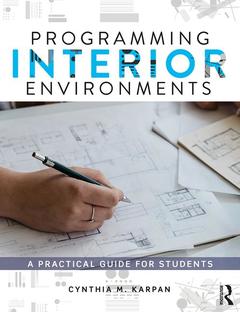Programming Interior Environments A Practical Guide for Students
Auteur : Karpan Cynthia

Programming Interior Environments introduces a four-component framework you can use to program interiors, and twelve methods for you to gather, analyze and synthesize programmatic information to take the guesswork out of your studio projects.
This book studies the Student Programming Model: a realistic programming process for college and university interior design students that allows students to create accurate and in-depth programming documents essential for informing the design process. This is done whilst keeping in mind that students are often working solo, with imaginary clients and end users in mind, and collecting program information within strict time constraints.
Including three appendices of student programs created following these guidelines, to help you understand how to apply the framework components and inquiry methods in your own work, this book is ideal for students and professionals in interior design and interior architecture.
TABLE OF CONTENTS
LIST OF FIGURES
LIST OF TABLES
ACKNOWLEDGEMENTS
CHAPTER 1: INTRODUCTION
Intended Audience
Programming
The Design Process
The Programming Process
The Program Document
Programming Advantages
Programming Disadvantages
Chapter Overviews
Summary and Chapter Overviews
Chapter Overviews
CHAPTER 2: MODERN-DAY PROGRAMMING
1957
Mid 1960s
1969
Late 1960s and Early 1970s
Late 1970s
1980s
1990s
2000 - 2010
2010 - 2020
Summary
CHAPTER 3: INTERIOR DESIGN PROGRAMMING MODELS
Seven Interior Design Programming Models
Student Programming Model Overview
Student Programming Model
Summary
CHAPTER 4: COLLECTION
Overview
Organize
Existing Condition
People
Workflow
Products
Site
Building and Space
Desired Condition
Context
People
Workflow
Products
Site
Building and Space
Collection Methods, Sources, and Products
Collection Methods
Collection Sources
Collection Products
Summary
CHAPTER 5: ANALYSIS
Overview
Themes
Options
Project Objectives
Design Guidelines
Analysis Methods
Dissect (Text)
Crunch (Numbers)
Assess
Annotate
Draw
Analysis in Action
Analysis Products
Summary
CHAPTER 6: SYNTHESIS
Methods
Constant Comparison
Priorities
Content Options
Abstract
Executive Summary
Table of Contents, List of Figures, List of Tables
Project Overview
Project Goals, Assumptions, and Objectives
Site, Building, and Space Descriptions
Building Code Information
Client Description
Workflow
End User Profiles, Needs, and Activities
Activity Zone Requirements
Area Requirements
Spatial Adjacency Matrices
Zoning and Stacking Diagrams
Circulation Diagrams
Design Guidelines
Schematic Concept Drawings
References
Appendices
Content Format and Order
Synthesis Products
Summary
CHAPTER 7: EVALUATE AND REVISE, COMMUNICATE
Evaluation
Review
Compare
Revise
Communicate
Audience
Purpose
Time
Summary
CHAPTER 8: SUMMARY AND CONCLUSION
Summary
Conclusion
APPENDIXES
A Blackthorn Live/CreateProgram
B The HUBProgram
C Extreme Toy Hauler Mobile ShowroomProgram
INDEX
Cynthia M. Karpan is an Associate Professor of Interior Design at the University of Manitoba in Winnipeg, Manitoba, Canada.
Date de parution : 12-2019
18.9x24.6 cm
Date de parution : 12-2019
18.9x24.6 cm
Disponible chez l'éditeur (délai d'approvisionnement : 14 jours).
Prix indicatif 50,12 €
Ajouter au panierThèmes de Programming Interior Environments :
Mots-clés :
News Casts; Programming; Spatial Adjacency Matrix; Interior Environments; Smart Phone; interiors; Studio Assignments; interior design; Information Collection Phase; interior architecture; Main Programmatic Activities; Programmatic Information; Existing Programming Models; Communicating Programmes; Interior Design Programming; programs; Room Data Sheet; program interiors; Interior Design Students; architectural program; Includes Design Guidelines; Programming Models; Primary End Users; Affinity Diagrams; Bubble Diagrams; Site visit; Client’s Workflow; Precedent Analysis; Occupancy Load; Spatial Adjacency Matrices; Fire Exits; Block Diagrams; Constant Comparison Method; adjacency diagram; Real Life Practice; design process; Draft Program; Student Programming Model; Information Gathering Methods; Zoning Diagrams; in-depth programming documents; Circulation Diagrams; Pre-design Activity; Innovative Design Solution; Program Document



